Much can be learned from past history. Therefore, this article will study the elements comprising the U.S. Homeland CBRN emergency preparedness enterprise of 1962 versus 2014 and address their similarities and differences. In 1962, the Cuban Missile Crisis occurred over a 13 day period in October. The crisis centered on the former Soviet Union placing intermediate-range nuclear missiles in Cuba.
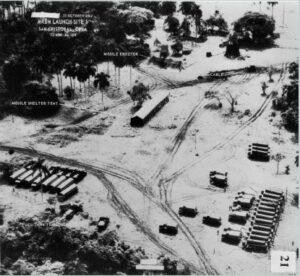
U.S. Navy low-level photograph of San Cristobal MRBM site no. 1on October 23, 1962. (Courtesy of “The Cuban Missile Crisis, 1962: The Photographs,” Dino A. Brugioni Collec-tion, The National Security Archive, The George Washing-ton University/Released)
The Cuban Missile Crisis was the closest the world ever came to a nuclear war. Fortunately, the negotiating efforts of President John F. Kennedy and Premier Nikita Khrushchev averted a nuclear war.
In 1961, President Kennedy created the Office of Emergency Preparedness inside the White House to handle the growing risk of natural disasters. He also created the Office of Civil Defense (OCD) in July 1961, which was part of the Department of Defense (DoD). As specified in the Presidential Executive Order 10952 dated July 20, 1961, the OCD was charged with, among several other duties, the “…development and execution of (i) a fallout shelter program; (ii) a chemical, biological and radiological warfare defense program; and (iii) all steps necessary to warn or alert Federal military and civilian authorities, state officials and the civilian population.”
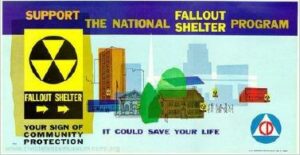
1962 Civil Defense Bus/Subway Poster (Courtesy of www.civildefensemuseaum.com/Released)
President Kennedy advocated the use of fallout shelters as part of the U.S. response to survive a nuclear attack by the Soviet Union. He believed the lives of families not directly hit in a nuclear attack could be saved if they could take shelter.
On August 14, 1961, President Kennedy signed Executive Order 10958. It delegated responsibility for civil defense food stockpiles to the Secretary of Agriculture and also civil defense medical stock-piles to the Secretary of Health, Education and Welfare (HEW).
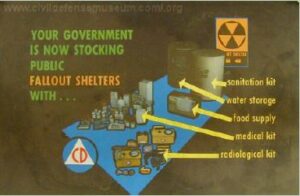
Civil Defense Light-Up Display Transparency (Courtesy of www.civildefensemuseaum.com/Released)
In the summer of 1961, at the request of President Kennedy, Congress appropriated $207.6 million to identify and mark spaces in existing buildings for fallout shelters, stock the shelters with food and other supplies, improve air-raid warning systems and include space for shelters in new Federal buildings. With these funds, the OCD, assisted by the Army Corps of Engineers and the U.S. Navy’s Bureau of Yards and Docks, began organizing surveys to identify possible fallout shelter spaces for 104 million Americans in existing structures. The OCD also began distributing large numbers of “Shelter Radiation Kits” that contained survey meters and dosimeters to public shelters and monitoring stations. OCD enacted many programs against the threat of a Soviet nuclear attack. This included booklets, brochures and videos on ways to protect one’s self and how to build a backyard or basement bomb shelter.
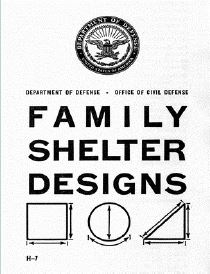
H-7 Family Shelter Designs handbook published in January 1962 by the Office of Civil Defense. (Courtesy of DoD/Released)
On February 16, 1962, Presidential Executive Orders 10997 through 11005 assigned emergency preparedness functions to the Secretary of the Interior, Secretary of Agriculture, Secretary of Commerce, Secretary of Labor, Secretary of HEW, Postmaster General, Administrator of the Federal Aviation Agency, Housing and Home Finance Administrator, and the Interstate Commerce Commission. Each one was required to prepare national emergency plans and develop preparedness programs. These plans and programs were designed to develop a state of readiness in these areas with respect to all conditions of national emergency, including attack upon the United States. The “attack upon the United States” included chemical, biological and radiological (CBR) attacks.
The focus of the U.S. civil defense program in the early 1960s was predominantly concerned with a nuclear strike by the Soviet Union against our homeland. The fallout shelters that were constructed during this period were designed to protect against nuclear fallout and not against chemical and biological agents.
On June 19, 1978, President Carter established the Federal Emergency Management Agency (FEMA). The role of FEMA was to consolidate emergency preparedness, mitigation and response activities into one federal emergency management organization. Until 2001, the U.S. civil defense duties were performed by FEMA. After the September 11, 2001 terrorist attacks against the United States, President George W. Bush issued Executive Order 13228 on October 8, 2001, establishing the Office of Homeland Security (OHS) and the Homeland Security Council.
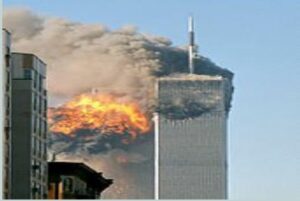
The north face of Two World Trade (south tower) immediately after being struck by United Airlines Flight 175 on September 11, 2001. (Courtesy of Wikimedia Commons/Released)
The function of the OHS was to coordinate the executive branch’s efforts to detect, prepare for, prevent, protect against, respond to and recover from terrorist attacks within the United States. OHS became the Department of Homeland Security (DHS) on November 25, 2002 by the Homeland Security Act of 2002. The five core missions of DHS are the following: (1) prevent terrorism and enhance security, (2) secure and manage our borders, (3) enforce and administer our immigration laws, (4) safeguard and secure cyber-space, and (5) ensure resilience to disasters.
FEMA was absorbed into DHS effective March 1, 2003. As a result, FEMA became part of the Emergency Preparedness and Response Directorate of DHS. It became FEMA again on March 31, 2007 but remains in DHS. FEMA has the U.S. civil defense mission as it relates to the U.S. national preparedness mission.
In January 2012, a new strategic guidance, Sustaining U.S. Global Leadership: Priorities for 21st Century Defense, was developed for DoD for sustaining U.S. global leadership for a 21st century defense. This guidance reflected President Obama’s strategic direction to DoD. Primary missions of the U.S. Armed Forces specified in this strategic guidance included counter terrorism, defend the homeland, provide support to civil authorities, and counter weapons of mass destruction (WMD).
As specified in Joint Publication 3-27, Homeland Defense, dated July 29, 2013, DoD is responsible for the homeland defense (HD) mission against employment of CBRN weapons directly against the United States. DoD leads the response with support from international partners and U.S. Government (USG) departments and agencies. DHS is the lead federal agency for homeland security (HS). DoD supports HS against possible covert CBRN weapons.
The 2014 Quadrennial Defense Review (QDR) was released by the Secretary of Defense on March 4, 2014. The QDR is a legislatively-mandated review of DoD strategy and priorities. The 2014 QDR prioritizes three strategic pillars in a period of fiscal austerity: (1) defend the homeland, (2) build security globally, and (3) project power and win decisively. The QDR discusses a world that is growing more volatile, more unpredictable, and in some instances, more threatening to the United States.
One section of the QDR contains an assessment of the QDR by General Martin E. Dempsey, Chairman of the Joint Chiefs of Staff. He states that he believes there are six national security interests for which we are responsible [Note: These are directly derived from the four core interests outlined in the National Security Strategy]. The first two are: (1) survival of the nation and (2) prevention of catastrophic attack against U.S. territory. He goes on to state that based on these six interests, he and the Joint Chiefs used the prioritization of 12 identified missions to advise the Secretary of Defense and President and determine how to distribute the force among our Combatant Commanders. The first and second most important missions are the following: maintain a secure and effective nuclear deterrent and provide for military defense of the homeland. The fifth and sixth most important missions are combat terrorism and counter WMD.
Funding for homeland defense against CBRN weapons remains a high priority. In the FY 2014 omnibus appropriations bill signed into law on January 17, 2014, DHS funding for such purpose includes the following:
- $81 million to implement “standards” to prevent terrorists from gaining access to chemicals that can be converted into WMDs
- $85 million for the BioWatch program to improve the Nation’s biological detection capabilities
- $404 million for the National Bio and Agro Defense Facility to conduct research to prevent the accidental or intentional intro-duction of deadly animal diseases into the U.S.
- $285 million for the Domestic Nuclear Detection Office to improve the Nation’s capability to detect and report unauthorized attempts to import, possess, store, develop or transport nuclear or radiological material for use against the Nation
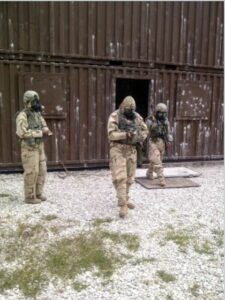
Soldiers from the Maryland Army National Guard’s 231st Chemical Company, based in Greenbelt, Md. scan a simulated village for chemical weapons during a Sept. 8, 2013 training exercise at Gunpowder Military Reservation. (National Guard photo by 1st Lt. Kristofer Baumgartner/Released)
When one compares the elements of CBRN emergency prepared-ness in 1962 versus 2014, the similarities are the following:
- Protection of the homeland to deter and defeat attacks on the United States is of the highest importance.
- DoD leads the homeland defense mission, if the homeland is attacked by CBRN weapons.
- Our nuclear deterrent is the ultimate protection against a nu-clear attack on the United States.
- Guidance/direction on protection of the homeland has emanated from the President of the U.S.
- The Homeland CBRN emergency preparedness enterprise entails both non-DoD and DoD entities and requires coordinated and integrated activities among and between these different organizations.
- Homeland defense against CBR (CBRN) attacks is a very high priority.
Several differences that exist today versus 1962 are the following:
- U.S. Homeland CBR civil defense (emergency preparedness) mission resided with DoD in 1962, and today the CBRN emergency preparedness mission is with FEMA in DHS.
- In 1962, the nuclear capable nations, for all intents and purposes, were the U.S. and the Soviet Union. Today, the number of nuclear capable nations is much larger and continues to grow.
- Today, terrorist networks continue to demonstrate interest in obtaining WMD. Terrorist attacks involving WMD were not really considered a threat in 1962.
The CBRN threats today are more diverse and broader than the ones in 1962. The CBR emergency preparedness enterprise of 1962 had many elements in common with the CBRN emergency preparedness enterprise of today. However, the key difference between the CBRN emergency preparedness enterprise of today versus 1962 is that the full spectrum of CBRN threats drives the enterprise; whereas in 1962, the nuclear threat was the predominant threat driving the enterprise.
About the Author:
Mr. Dennis Metz, Vice President of SciTech Services, Inc., has over 41 years of experience in chemical and biological warfare, chemical and biological defense, target defeat, and WMD casualty effects technology areas. Mr. Metz has conducted projects encompassing all chemical and biological defense functional areas, ranging from threat modeling, detection, decontamination and protection, to arms control.


